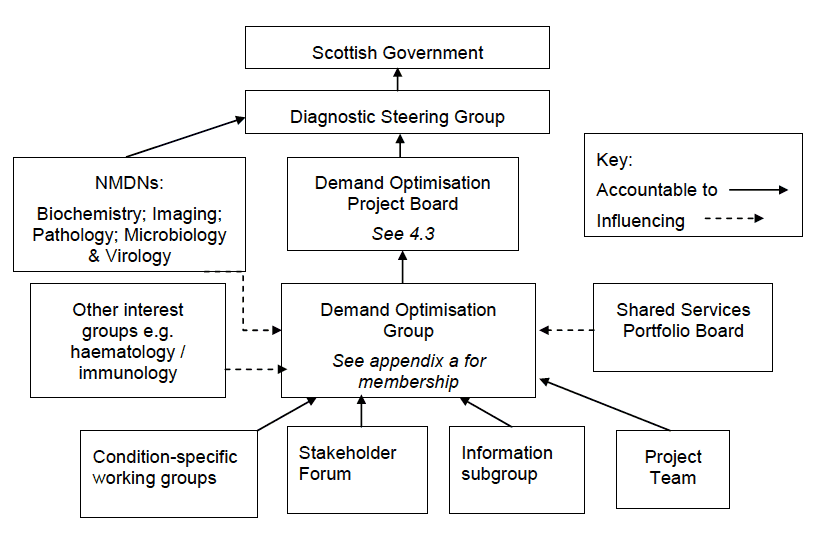Demand optimisation in diagnostics: standardising diagnostic testing in NHS Boards
Report highlighting current good practice, guidance on strategy and support for implementing demand optimisation.
Section 1: Introduction
1.1 Background
Demand Optimisation in Diagnostic Services
It has been recognised for many years that there is considerable variation in the use of diagnostic tests across the NHS. While some of this variation can be explained by clinical circumstances and demographic differences, much of the variation is suggestive of considerable levels of inappropriate requesting by clinicians as a result of over-requesting, under-requesting and unnecessary repeat testing. In addition, lack of availability of certain tests across the NHS Boards may also limit their optimal use.
Demand Optimisation is defined as the process by which diagnostic test use is optimised to maximise appropriate testing which in turn optimises clinical care and drives more efficient use of scarce resource. The process needs to consider:
- Minimising over-requesting and under-requesting, both of which can be damaging to optimal patient care.
- Reducing unnecessary repeat requesting.
- Ensuring appropriate and useful test repertoires are universally available across all healthcare outlets.
- Standardisation to reduce unnecessary variation - especially around IT definitions and clinical pathways that utilise diagnostic tests.
It remains vital to acknowledge that the optimisation of rational diagnostic testing may bring about more efficient use of resources within diagnostics, however it is the knock-on effect for patient care pathways and the associated clinical impact that are much more important. The concept that investing more financial resource within diagnostics can in fact result in cost savings to the wider NHS way in excess of the original investment needs to be considered, explored and implemented - this invest to save approach has been used in particular to justify the implementation of newer, more costly diagnostic tests in recent years.
Demand Optimisation interest has been rising for many years and it has become a focus programme within the Scottish Government's Healthcare Science National Delivery Plan. In 2015, the Scottish Government requested that a National Demand Optimisation Group ( NDOG) be established. This multidisciplinary group was formed in 2016 and has been developing a number of aims and workstreams around demand optimisation.
It is within the interests of healthcare provision across NHS Scotland that a joined up, focused, patient centred programme around Demand Optimisation be developed and adopted so that diagnostic testing can be made more appropriate, consistent and cost effective - ensuring that for every patient, the right test, at the right time is available and is carried out without unnecessary waste or potential harmful knock-on effects. Using appropriately delivered diagnostic testing to drive efficient healthcare pathways across the NHS remains the ultimate goal.
1.2 Group Membership
The multidisciplinary National Demand Optimisation Group ( NDOG) was formed in 2016 and has been developing a number of aims and workstreams around demand optimisation. The group has representation from Scottish Government, National Services Scotland, the National Managed Diagnostic Networks, as well as representation from laboratories including Biochemistry, Microbiology / Virology, Pathology, Haematology and Clinical Immunology. There is also representation from Clinical Imaging, Genetics/Molecular Consortia and the Scottish National Blood Transfusion Service. There are Demand Optimisation subgroups currently operating within the Clinical Imaging and Biochemistry networks. Full details of the group membership can be found in Appendix A.
1.3 Governance of NDOG
Scottish Government's Healthcare Science Lead resourced NHS National Services Scotland to provide administrative support to the NDOG for an initial 12 month period, to deliver an improvement plan to optimise diagnostic testing for patients and to support the implementation of the National Clinical Strategy and Scottish Government's Healthcare Science National Delivery Plan. An initial scoping exercise was undertaken to identify stakeholders and agree the scope of the work. The governance structure employed in the work was -
Figure 1: NDOG Governance arrangement

A website was established and regular bulletins issued to highlight the work of the NDOG. Members also linked with relevant activity at a local and national level, to capture a true Scotland-wide picture of demand optimisation activity.
Contact
Email: Karen Stewart
There is a problem
Thanks for your feedback